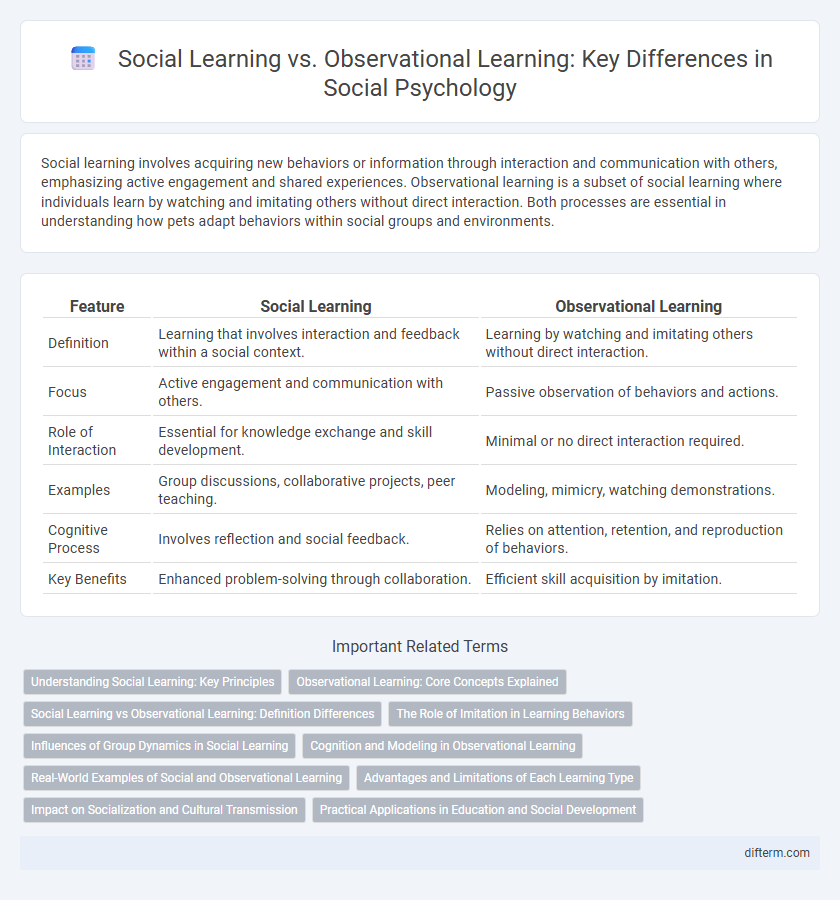Social learning involves acquiring new behaviors or information through interaction and communication with others, emphasizing active engagement and shared experiences. Observational learning is a subset of social learning where individuals learn by watching and imitating others without direct interaction. Both processes are essential in understanding how pets adapt behaviors within social groups and environments.
Table of Comparison
| Feature | Social Learning | Observational Learning |
|---|---|---|
| Definition | Learning that involves interaction and feedback within a social context. | Learning by watching and imitating others without direct interaction. |
| Focus | Active engagement and communication with others. | Passive observation of behaviors and actions. |
| Role of Interaction | Essential for knowledge exchange and skill development. | Minimal or no direct interaction required. |
| Examples | Group discussions, collaborative projects, peer teaching. | Modeling, mimicry, watching demonstrations. |
| Cognitive Process | Involves reflection and social feedback. | Relies on attention, retention, and reproduction of behaviors. |
| Key Benefits | Enhanced problem-solving through collaboration. | Efficient skill acquisition by imitation. |
Understanding Social Learning: Key Principles
Social learning involves acquiring new behaviors through direct interaction and engagement with others, emphasizing collaboration and communication within a social context. Observational learning, a subset of social learning, occurs by watching and imitating others' actions without explicit reinforcement or direct involvement. Key principles include attention, retention, reproduction, and motivation, which collectively facilitate the internalization and application of observed behaviors in social environments.
Observational Learning: Core Concepts Explained
Observational learning, a key component of social learning theory, involves acquiring new behaviors by watching and imitating others, emphasizing attention, retention, reproduction, and motivation processes. This learning method enables individuals to internalize skills and attitudes without direct experience or reinforcement. Bandura's Bobo doll experiment exemplifies how observational learning shapes behavior through modeling and social cues.
Social Learning vs Observational Learning: Definition Differences
Social learning involves acquiring behaviors, skills, and knowledge through interaction with others, emphasizing collaboration and shared experiences, while observational learning specifically refers to learning by watching the actions and consequences observed in others without direct interaction. Social learning encompasses a broader range of processes including imitation, modeling, and active participation, whereas observational learning is often considered a subset focused primarily on visual observation and replication. The key difference lies in the interactive and participatory nature of social learning compared to the more passive, observational aspect of observational learning.
The Role of Imitation in Learning Behaviors
Imitation serves as a fundamental mechanism in both social learning and observational learning, enabling individuals to acquire new behaviors by replicating others' actions. In social learning, imitation facilitates the transmission of complex cultural practices and norms within groups, while observational learning emphasizes the acquisition of skills through watching models without direct reinforcement. The effectiveness of imitation depends on factors such as attention, motivation, and the perceived similarity between the learner and the model.
Influences of Group Dynamics in Social Learning
Group dynamics significantly shape social learning by facilitating the exchange of knowledge and reinforcing behaviors within peer interactions. Social learning capitalizes on shared goals and cooperative engagement, enhancing motivation and retention through group cohesion and normative influence. Observational learning, while also influenced by group presence, primarily depends on the modeling of specific behaviors, but its effectiveness is heightened when group dynamics promote active participation and feedback.
Cognition and Modeling in Observational Learning
Observational learning engages cognitive processes by enabling individuals to mentally encode, rehearse, and replicate behaviors modeled by others, enhancing skill acquisition without direct experience. Modeling in observational learning leverages attention, retention, reproduction, and motivation mechanisms to facilitate the internalization of social behaviors and problem-solving strategies. This cognitive framework supports adaptive learning by allowing individuals to abstract and generalize observed behaviors across diverse social contexts.
Real-World Examples of Social and Observational Learning
Social learning occurs when individuals acquire new behaviors through direct interaction and collaboration, such as students engaging in group projects to enhance problem-solving skills. Observational learning takes place when individuals imitate behaviors by watching others, exemplified by children copying adult manners or athletes modeling techniques demonstrated by professionals. In workplaces, social learning manifests through mentorship programs, while observational learning is visible when employees learn safety protocols by observing experienced colleagues.
Advantages and Limitations of Each Learning Type
Social learning enables individuals to acquire skills and knowledge through direct interaction and collaboration, fostering deeper understanding and motivation, but it may be constrained by group dynamics and varying participant engagement. Observational learning allows for efficient knowledge transfer by imitation of models without active participation, making it practical for acquiring behaviors quickly; however, it may lead to inaccurate or incomplete learning if the observed behaviors are flawed. Both learning types complement each other, yet social learning excels in contextual adaptation while observational learning is advantageous for rapid skill acquisition.
Impact on Socialization and Cultural Transmission
Social learning facilitates active interaction within groups, enhancing communication skills and fostering empathy, which significantly impacts socialization. Observational learning allows individuals to acquire behaviors and norms by watching others, accelerating cultural transmission across generations. Both processes are crucial for maintaining societal cohesion and promoting cultural continuity in diverse communities.
Practical Applications in Education and Social Development
Social learning facilitates collaborative environments where students engage directly with peers, enhancing communication and teamwork skills essential for social development. Observational learning enables learners to acquire behaviors and problem-solving techniques by watching models, which is particularly effective in classrooms using demonstrations and role-playing strategies. Integrating both methods supports practical applications such as peer mentoring programs and social skills training, fostering holistic educational growth and community interaction.
social learning vs observational learning Infographic

 difterm.com
difterm.com